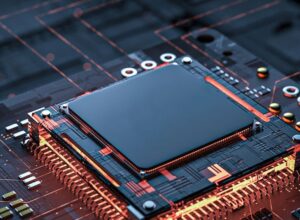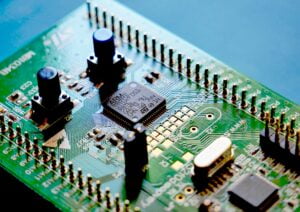Developing IoT devices requires a strategic understanding of hardware selection, system integration, and application-specific requirements. In this IoT device development guide, we explore the critical factors to consider when choosing between an MCU, SoC, or MPU for your next IoT hardware development project.
Choosing the right processing unit is vital to ensure that the device delivers the required performance, power efficiency, and scalability. Let’s dive into the essentials of IoT devices development and how to make the right decision.
1. Understanding the Options: MCU, SoC, and MPU
1.1 Microcontroller (MCU)
MCU is an all-in-one chip integrating processor, memory, and peripherals, making it suitable for low-power, cost-sensitive, and simple control applications. Common use cases include:
- Sensor control
- Data collection
- Basic communication (e.g., UART, SPI, I2C)

Features:
- Low power consumption: Ideal for battery-powered devices.
- Real-time response: Quickly reacts to external events.
- Low development cost: Suitable for resource-constrained projects.
Popular MCU Models:
- STM32 series (STMicroelectronics): A balanced choice for performance and power efficiency.
- TI MSP430 series: Ultra-low power, suitable for industrial and medical devices.
- Nordic nRF52 series: Integrated Bluetooth, ideal for wearable devices.
- Domestic models: GD32 series (GigaDevice): Low-cost and STM32-compatible.
1.2 System-on-Chip (SoC)
SoC integrates processor, memory, communication modules (e.g., Wi-Fi, Bluetooth), GPU, and other functional units, offering high performance and multifunctionality. Typical applications include:
- Smart home devices (smart speakers, cameras)
- Edge computing nodes
- Advanced sensor networks

Features:
- High integration: Reduces peripheral complexity.
- Multifunctionality: Supports various communication protocols.
- Suitable for multitasking: Meets data processing needs.
Popular SoC Models:
- ESP32 (Espressif): Built-in Wi-Fi and Bluetooth, widely used in smart home devices.
- Ambiq Apollo series: Ultra-low power, suitable for wearable devices.
- Domestic models: RK3568 (Rockchip): Supports high-performance computing and multimedia processing.
1.3 Microprocessor (MPU)
MPU typically runs full-fledged operating systems like Linux, making it ideal for high-computing and multitasking applications. Primary use cases include:
- Industrial automation
- Smart gateways
- Advanced human-machine interface devices

Features:
- High performance: Suitable for complex calculations and large-scale data processing.
- Supports operating systems: Highly flexible.
- Requires external peripherals: Needs external RAM, storage, and other components.
Popular MPU Models:
- NXP i.MX series: Supports multimedia processing and industrial control.
- TI Sitara series: Suitable for industrial automation and smart gateways.
- Domestic models: RK3399 (Rockchip): Supports 4K video and AI computation.
2. Key Considerations in Developing IoT Devices
When developing IoT devices, several technical and business factors should guide your choice of processing unit:
2.1 Power Consumption
In IoT hardware development, especially for battery-operated devices, low power consumption is crucial. MCUs generally consume less power than SoCs and MPUs, making them ideal for energy-sensitive applications.
2.2 Performance Requirements
IoT devices development must align hardware capabilities with application demands. Applications involving real-time data processing, machine learning, or multimedia often require SoCs or MPUs for adequate performance.
2.3 Connectivity Needs
Many modern IoT device development projects require integrated wireless communication (e.g., Wi-Fi, Bluetooth, Zigbee). SoCs often offer built-in wireless modules, simplifying the hardware design.
2.4 Security Features
Security is paramount in IoT hardware development. Choosing a processing unit with built-in security modules such as secure boot, encryption engines, and trusted execution environments is vital.
2.5 Operating System Support
MPUs can run full operating systems like Linux or Android, offering greater flexibility for complex applications. For simpler, bare-metal systems or real-time operating systems (RTOS), MCUs are often sufficient.
2.6 Development Ecosystem and Support
A strong development ecosystem—comprising software tools, community support, and documentation—can significantly accelerate the development of IoT devices.
3. How to Choose the Right Processor for Your IoT Device Development
When choosing between MCU, SoC, or MPU, consider the following factors:
Power Consumption Requirements
- Low-power scenarios: For battery-powered devices and environmental monitoring nodes, MCU or low-power SoC is preferable.
- High-computing requirements: For video processing or edge AI, SoC or MPU is recommended.
Performance and Task Complexity
- Simple control tasks: An MCU suffices.
- Multitasking or complex data processing: SoC or MPU is necessary.
Development Cost and Time
- Quick development: MCUs have shorter development cycles and fewer peripheral demands.
- Integrated functionality: SoC reduces hardware complexity but requires more software development.
4. Typical Use Cases and Popular Chip Models
4.1 Smart Home Devices
| Processor Type | Chip Model | Features |
|---|---|---|
| MCU | STM32F1 series | High performance, low power, suitable for smart lighting control. |
| SoC | ESP32 | Built-in Wi-Fi and Bluetooth, ideal for smart plugs and cameras. |
| MPU | RK3568 | Supports high-resolution video and multimedia processing, suitable for home gateways and smart speakers. |
4.2 Industrial IoT (IIoT)
| Processor Type | Chip Model | Features |
|---|---|---|
| MCU | GD32 series | Domestic low-cost, STM32-compatible, suitable for industrial sensor control. |
| SoC | Qualcomm QCA4020 | Multi-protocol support (Wi-Fi, Zigbee), ideal for industrial wireless networks. |
| MPU | TI AM335x series | Supports real-time operating systems, suitable for industrial automation and data collection. |
4.3 Wearable Devices
| Processor Type | Chip Model | Features |
|---|---|---|
| MCU | Nordic nRF52840 | Integrated Bluetooth, ultra-low power, suitable for fitness trackers and smart bands. |
| SoC | Ambiq Apollo4 | Efficient AI processing, suitable for smartwatches. |
| MPU | N/A | Rarely used in wearables due to high power requirements. |
5. Performance and Power Consumption Comparison
Performance and power consumption are crucial factors in IoT device development. Different scenarios prioritize these metrics differently. For instance, battery-powered sensor nodes emphasize low power, while edge computing devices prioritize processing performance.
MCUs typically balance low power consumption and moderate performance. They are ideal for simple tasks like sensor control and real-time data collection. Chips like STM32 and GD32 operate under 1mA of current, making them suitable for low-power IoT scenarios.
SoCs offer higher integration and performance, supporting multitasking and communication modules. For example, the ESP32 integrates Wi-Fi and Bluetooth, making it a top choice for smart home devices. However, its power consumption is slightly higher than MCUs, requiring optimization in design.
MPUs focus on high-performance scenarios such as edge AI and multimedia processing. Chips like RK3399 and NXP i.MX series run complex algorithms and multitasking operations but have higher power consumption. Thus, MPUs are often used in powered devices like industrial gateways or multimedia hubs.
| Metric | MCU | SoC | MPU |
|---|---|---|---|
| Compute Power | Low to Medium | Medium to High | High |
| Power Consumption | Low | Medium | High |
| Integration | High | Very High | Moderate |
| Cost | Low | Medium | High |
| Development Complexity | Low | Medium | High |
In summary, developers must balance performance and power consumption based on their specific application. MCUs are suitable for low-power devices, SoCs for multifunctional wireless devices, and MPUs for high-performance, complex systems.
6. Final Thoughts
When choosing between MCU, SoC, or MPU, developers should balance performance, power consumption, and development complexity based on specific device requirements and budget:
- Low power and simple tasks: Choose an MCU, such as the STM32 or GD32 series.
- Multifunctionality and wireless communication: Opt for an SoC, such as the ESP32 or RK3568.
- High computing demand and multitasking: Select an MPU, such as the RK3399 or NXP i.MX series.
By selecting the right processor, developers can significantly enhance IoT device performance and reliability while optimizing development costs and timelines.
Need help with your IoT devices development?
ZedIoT offers expert consulting and development services to bring your IoT vision to life. Contact us today to discuss your project!


